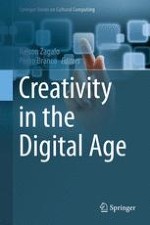2015 | OriginalPaper | Chapter
7. An Enactive Model of Creativity for Computational Collaboration and Co-creation
Authors : Nicholas Davis, Chih-Pin Hsiao, Yanna Popova, Brian Magerko
Published in: Creativity in the Digital Age
Publisher: Springer London
Activate our intelligent search to find suitable subject content or patents.
Select sections of text to find matching patents with Artificial Intelligence. powered by
Select sections of text to find additional relevant content using AI-assisted search. powered by
